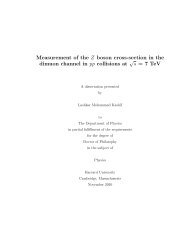2 The CDF Experiment at Fermilab Contents - Harvard University ...
2 The CDF Experiment at Fermilab Contents - Harvard University ...
2 The CDF Experiment at Fermilab Contents - Harvard University ...
Create successful ePaper yourself
Turn your PDF publications into a flip-book with our unique Google optimized e-Paper software.
Section 2: DAQ for the Silicon Vertex Detector 25<br />
Our Involvement in SVX Software<br />
In the Spring of 1997, the rst version of the SVX online software was written <strong>at</strong> <strong>Harvard</strong>,<br />
by Gay, Spiropulu and Novak. Although it began as the control software for the SRC, due<br />
to its exibility and clarity it was soon accepted by the rest of the SVX DAQ group, and<br />
then as the core of the <strong>CDF</strong>-wide protocol for controlling the boards in VME cr<strong>at</strong>es.<br />
Motiv<strong>at</strong>ed by the need for testing the SRC <strong>at</strong> <strong>Harvard</strong> { in absence of any other SVX<br />
DAQ boards { the <strong>Harvard</strong> group began utilizing General System Test Modules (GSTMs),<br />
developed by <strong>Fermilab</strong>'s ESE group. Each GSTM is a generic board with several FIFOs and<br />
ports for several types of daughter cards { each emul<strong>at</strong>ing a type of connection { th<strong>at</strong> can be<br />
<strong>at</strong>tached to the GSTM. In this way a GSTM, adequ<strong>at</strong>ely controlled by software, can emul<strong>at</strong>e<br />
any part of the SVX DAQ system. <strong>The</strong> low-level GSTM code has been written by Bailey and<br />
Maksimovic. A high-level test-stand framework was proposed by Bailey and Maksimovic,<br />
was implemented by other members of the SVX DAQ software team, and was extensively<br />
used to test VRBs and FIBs using code written by Maksimovic th<strong>at</strong> lets a GSTM emul<strong>at</strong>e<br />
a FIB or a VRB. <strong>The</strong> GSTMs are currently being employed in testing the Hit Finder board<br />
of the Secondary Vertex Tracker system (SVT).<br />
<strong>The</strong> SRC software was improved and is maintained mostly by Bailey, who also coded<br />
various software tests appropri<strong>at</strong>e for a stand-alone SRC test-stand (such is the one <strong>at</strong><br />
<strong>Harvard</strong>). Both Bailey and Maksimovic wrote tests th<strong>at</strong> probe the functionality of the SRC<br />
in the environment of the SVX DAQ (such is the one <strong>at</strong> <strong>Fermilab</strong>) { tests th<strong>at</strong> involve all<br />
elements of the system from the SVXIII chip up, and the ways they interact with the SRC.<br />
Future Plans<br />
At this point the basic functionality of the SRC has been tested and the majority of<br />
the work is in the context of its integr<strong>at</strong>ion with the rest of the system. This involves ne<br />
tuning existing fe<strong>at</strong>ures, performing stress tests of its capabilities, and occasionally adding<br />
new fe<strong>at</strong>ures to accommod<strong>at</strong>e a specic test of the complete system. We are also writing<br />
document<strong>at</strong>ion for the testing and maintenance of the SRC to facilit<strong>at</strong>e any trouble shooting<br />
or repairs th<strong>at</strong> may need to be done in future years when we are not working on the SRC<br />
on a daily basis.<br />
In the next year Maksimovic and Bailey will be applying their experience with the SVX-<br />
DAQ system to aid in the construction and testing of the SVXII detector and will be involved















